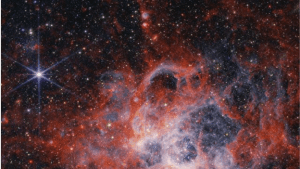TAG: GS 3: SCIENCE AND TECHNOLOGY
THE CONTEXT: The James Webb Space Telescope (JWST) has recently captured stunning images of NGC 604, a star-forming region located in the nearby Triangulum galaxy.
EXPLANATION:
- Despite being millions of light-years away from Earth, NGC 604 offers a remarkable opportunity for astronomers to study massive young stars in their early stages of life.
- We will explore the significance of NGC 604, the characteristics of its stellar population, and the insights it provides into the process of star formation.
NGC 604:
- NGC 604 is a massive star-forming region within the Triangulum galaxy.
- It shares similarities with other star-forming regions, such as the famous Orion Nebula, but stands out due to its larger size and higher concentration of recently-formed stars.
- This region serves as a microcosm of distant “starburst” galaxies that experienced rapid rates of star formation.
- Despite being 2.73 million light-years away from Earth, NGC 604 is considered “close” in astronomical terms.
- This proximity, albeit vast from a human perspective, allows astronomers to observe the region with unprecedented detail.
- It highlights the vastness of the universe, where distances are measured in light-years, yet certain phenomena appear within reach for observational study.
- NGC 604 shelters approximately 200 of the hottest and most massive types of stars known as B-type and O-type stars.
- These stars are in the early stages of their lives, emitting intense radiation and stellar winds that sculpt the surrounding gas clouds.
- O-type stars, in particular, can exceed 100 times the mass of the Sun, making them rare and intriguing subjects for study.
- The high concentration of massive stars within NGC 604, combined with its relative proximity, presents astronomers with a unique opportunity to investigate these cosmic giants in their infancy.
- Such close proximity allows for detailed observations that would be challenging or impossible with more distant objects.
- Studying star-forming regions like NGC 604 provides valuable insights into the process of star formation and the environments in which it occurs.
- The images captured by the Webb Telescope reveal intricate structures, including tendrils and clumps of emissions depicted in bright red.
- These features are indicative of the complex interplay between stellar winds and ionizing radiation from young stars, which carve out voids or “holes” in the surrounding gas clouds.


